Dynamic Simulation Model and Performance Optimization of a Pressurized Pulsed Water Jet Device
Abstract
:1. Introduction
2. Formation Principle of PPWJ
2.1. Structure of the PPWJ Device
2.2. Operational Principle of the PPWJ Device
2.3. Analysis of the Pulse Parameters of a PPWJ
3. Simulation of Dynamic Characteristics of the PPWJ Device
3.1. Simulation Model
3.2. Governing Equations
3.2.1. Dynamic Equation of the Piston
3.2.2. Dynamic Equation of the Valve Core
3.2.3. The Flow Rate Continuity Equation
3.2.4. Simulation Parameters
3.3. Simulation Results
3.4. Numerical Model Verification
4. Effect of Key Structural Parameters of the PPWJ Device on Jet Characteristics
4.1. Effect of Nozzle Diameter dn
4.2. Effect of Piston Maximum Displacement h
4.3. Effect of Piston Diameter dp3
4.4. Effect of Piston Diameter dp1 and dp2
5. Performance Optimization of the PPWJ Device
5.1. Optimization Process
5.1.1. Design Variable
5.1.2. Objective Function
5.1.3. Constraint Condition
5.1.4. Optimization Criteria
5.1.5. Optimization Results
5.2. Experiment on Rock Breaking by PPWJ
5.2.1. Experimental Apparatus and Procedures
5.2.2. Results and Discussion
6. Conclusions
- The simulation model of a jet-generation system was constructed, and the motion laws of the piston and reversing spool and the evolution characteristics of the inlet pressure and jet pressure were analyzed. The piston and valve core move reciprocally in a limited stroke. There is a short pause when the reversal of the valve core is completed, and the displacement curve is approximately trapezoidal. There is no pause during the movement of the piston, and the displacement curve is approximately sawtooth-shaped. The pressure state of the jet corresponds to the motion state of the piston one by one. The low-pressure stage and boosting stage of the jet correspond to the backward stage and stroke stage of the piston, respectively.
- The effect of the key structural parameters of the device on jet characteristics was analyzed. When the nozzle diameter or boost ratio exceeds a certain value, the pulse pressure drops and the pulse duration and pulse frequency no longer change; there is an optimal nozzle diameter or boost ratio to maximize the pulse pressure and pulse frequency. In addition, with the increase in piston maximum displacement or piston diameter dp2, the pulse duration increases and pulse frequency decreases. When the piston maximum displacement or piston diameter dp2 is lower than a certain value, the pulse pressure decreases. In addition, pulse pressure is not affected by piston diameter dp3; the increase in piston diameter dp3 results in the increase in pulse duration and decrease in pulse frequency.
- The design criterion of the key structural parameters of the generator was established, and the optimal parameters were obtained based on the design criterion and simulation results. Compared with the original device, both the pulse frequency and output energy of the jet generated by the optimized device are significantly improved without reducing the pulse pressure. The rock breaking test results show that the diameter and volume of the granite erosion pit generated by the optimized device are 1.4 and 1.5 times those generated by the original device, respectively.
Author Contributions
Funding
Institutional Review Board Statement
Informed Consent Statement
Data Availability Statement
Acknowledgments
Conflicts of Interest
References
- Guha, A.; Ronald, R.M.; Balachandar, R. An experimental and numerical study of water jet cleaning process. J. Mater. Process. Technol. 2011, 211, 610–618. [Google Scholar] [CrossRef]
- Flower, G.; Pashby, I.R.; Shipway, P.H. The effect of particle hardness and shape when abrasive water jet milling titanium alloy Ti6Al4V. Wear 2009, 266, 613–620. [Google Scholar]
- Muruganandhan, R.; Mugilvalavan, M.; Thirumavalavan, K.; Yuvaraj, N. Investigation of water jet peening process parameters on AL6061-T6. Surf. Eng. 2018, 34, 330–340. [Google Scholar] [CrossRef]
- Cheng, J.L.; Jiang, Z.H.; Han, W.F.; Li, M.L.; Wang, Y.X. Breakage mechanism of hard-rock penetration by TBM disc cutter after high pressure water jet precutting. Eng. Fract. Mech. 2020, 240, 107320. [Google Scholar] [CrossRef]
- He, L.; Liu, Y.; Shen, K.; Yang, X.; Ba, Q.; Xiong, W. Numerical research on the dynamic rock breaking process of impact drilling with multi-nozzle water jets. J. Pet. Sci. Eng. 2021, 207, 109145. [Google Scholar] [CrossRef]
- Jiang, T.; Huang, Z.; Li, J.; Li, H. Effect of parameters on threshold pressure of sandstone tested by water jet. Int. J. Rock Mech. Min. Sci. 2021, 207, 109145. [Google Scholar] [CrossRef]
- Lu, Y.; Xiao, S.; Ge, Z.; Zhou, Z.; Ling, Y.; Wang, L. Experimental study on rock breaking performance of water jets generated by self-rotatory bit and rock failure mechanism. Powder Technol. 2019, 346, 203–216. [Google Scholar] [CrossRef]
- Xue, Y.; Si, H.; Yang, Z.; Xu, D. Microscopic damage field in coal induced by water jets. J. Loss Prev. Process Ind. 2018, 56, 300–315. [Google Scholar] [CrossRef]
- Xiao, S.; Ren, Q.; Cheng, Y.; Zhao, H.; Cao, S.; Zhang, L.; Chen, B.; Meng, X. Damage and fracture characteristics of rocks with different structures under high-velocity water jet impact. Eng. Fract. Mech. 2021, 256, 107961. [Google Scholar] [CrossRef]
- Lu, Y.; Huang, F.; Liu, X.; Ao, X. On the failure pattern of sandstone impacted by high-velocity water jet. Int. J. Impact Eng. 2015, 76, 67–74. [Google Scholar] [CrossRef]
- Momber, A.W. The response of geo-materials to high-speed liquid drop impact. Int. J. Impact Eng. 2016, 89, 83–101. [Google Scholar] [CrossRef]
- Xue, Y.; Si, H.; Hu, Q. The propagation of stress waves in rock impacted by a pulsed water jet. Powder Technol. 2017, 320, 179–190. [Google Scholar] [CrossRef]
- Abulimiti, A.; Zheng, C.; Liu, Y.; Pang, H.; Pang, D.; Anwaier, M.; Guo, X. Study on the impacting performance of a self-excited oscillation pulsed jet nozzle. J. Pet. Sci. Eng. 2021, 207, 109120. [Google Scholar] [CrossRef]
- Li, D.; Kang, Y.; Wang, X.; Ding, X.; Fang, Z. Effects of nozzle inner surface roughness on the cavitation erosion characteristics of high speed submerged jets. Exp. Therm. Fluid Sci. 2016, 74, 444–452. [Google Scholar] [CrossRef]
- Li, D.; Kang, Y.; Ding, X.; Wang, X.; Fang, Z. Effects of area discontinuity at nozzle inlet on the characteristics of high speed self-excited oscillation pulsed waterjets. Exp. Therm. Fluid Sci. 2016, 79, 254–265. [Google Scholar] [CrossRef]
- Li, D.; Kang, Y.; Ding, X.; Wang, X.; Liu, W. Effects of feeding pipe diameter on the performance of a jet-driven Helmholtz oscillator generating pulsed waterjets. J. Mech. Sci. Technol. 2017, 31, 1203–1212. [Google Scholar] [CrossRef]
- Zhou, Z.; Ge, Z.; Lu, Y.; Zhang, X. Experimental study on characteristics of self-excited oscillation pulsed water jet. J. Vibroeng. 2017, 19, 1345–1357. [Google Scholar] [CrossRef]
- Zhang, X.; Li, X.; Nie, S.; Wang, L.; Dong, J. Study on velocity and pressure characteristics of self-excited oscillating nozzle. J. Braz. Soc. Mech. Sci. Eng. 2021, 43, 5. [Google Scholar] [CrossRef]
- Liu, W.; Kang, Y.; Zhang, M.; Wang, X.; Li, D. Self-sustained oscillation and cavitation characteristics of a jet in a Helmholtz resonator. Int. J. Heat Fluid Flow 2017, 68, 158–172. [Google Scholar] [CrossRef]
- Liu, W.; Kang, Y.; Zhang, M.; Wang, X.; Li, D.; Xie, L. Experimental and theoretical analysis on chamber pressure of a self-resonating cavitation waterjet. Ocean Eng. 2018, 151, 33–45. [Google Scholar] [CrossRef]
- Liu, W.; Kang, Y.; Wang, X.; Liu, Q.; Fang, Z. Integrated CFD-aided theoretical demonstration of cavitation modulation in self-sustained oscillating jets. Appl. Math. Model. 2020, 79, 521–543. [Google Scholar] [CrossRef]
- Kolsek, T.; Jelic, N.; Duhovnik, J. Numerical study of flow asymmetry and self-sustained jet oscillations in geometrically symmetric cavities. Appl. Math. Model. 2007, 31, 2355–2373. [Google Scholar] [CrossRef]
- Szada-Borzyszkowska, M.; Kacalak, W.; Banaszek, K.; Pude, F.; Perec, A.; Wegener, K.; Królczyk, G. Assessment of the effectiveness of high-pressure water jet machining generated using self-excited pulsating heads. Int. J. Adv. Manuf. Technol. 2024, 133, 5029–5051. [Google Scholar] [CrossRef]
- Vijay, M.M.; Foldyna, J. Ultrasonically modulated pulsed: Basic study. In Proceedings of the 12th International Conference on Jet Cutting Technology, Rouen, France, 25–27 October 1994; Volume 13, pp. 15–35. [Google Scholar]
- Foldyna, J.; Sitek, L.; Švehla, B.; Švehla, Š. Utilization of ultrasound to enhance high-speed water jet effects. Ultrason. Sonochem. 2004, 11, 131–137. [Google Scholar] [CrossRef] [PubMed]
- Zelenak, M.; Foldyna, J.; Scucka, J.; Hloch, S.; Riha, Z. Visualisation and measurement of high-speed pulsating and continuous water jets. Measurement 2015, 72, 1–8. [Google Scholar] [CrossRef]
- Tripathi, R.; Hloch, S.; Chattopadhyaya, S.; Klichová, D.; Ščučka, J.; Das, A.K. Application of the pulsating and continous water jet for granite erosion. Int. J. Rock Mech. Min. Sci. 2020, 126, 126. [Google Scholar] [CrossRef]
- Říha, Z.; Zeleňák, M.; Kruml, T.; Poloprudský, J. Comparison of the disintegration abilities of modulated and continuous water jets. Wear 2021, 478–479, 203891. [Google Scholar] [CrossRef]
- Raj, P.; Hloch, S.; Tripathi, R.; Srivastava, M.; Nag, A.; Klichová, D.; Klich, J.; Hromasová, M.; Muller, M.; Miloslav, L.; et al. Investigation of sandstone erosion by continuous and pulsed water jets. J. Manuf. Process 2019, 42, 121–130. [Google Scholar] [CrossRef]
- Tripathi, R.; Hloch, S.; Chattopadhyaya, S.; Klichová, D.; Klich, J. Influence of frequency during sandstone erosion by pulsed waterjet. Mater. Manuf. Process 2020, 35, 187–194. [Google Scholar] [CrossRef]
- Srivastava, M.; Hloch, S.; Tripathi, R.; Kozak, D.; Chattopadhyaya, S.; Dixit, A.R.; Foldyna, J.; Hvizdos, P.; Fides, M.; Adamcik, P. Ultrasonically generated pulsed water jet peening of austenitic stainless-steel surfaces. J. Manuf. Process 2018, 32, 455–468. [Google Scholar] [CrossRef]
- Hloch, S.; Adamčík, P.; Nag, A.; Srivastava, M.; Čuha, D.; Müller, M.; Hromasová, M.; Klich, J. Hydrodynamic ductile erosion of aluminium by a pulsed water jet moving in an inclined trajectory. Wear 2019, 428–429, 178–192. [Google Scholar] [CrossRef]
- Jiang, H.; Liu, Z.; Gao, K. Numerical simulation on rock fragmentation by discontinuous water-jet using coupled SPH/FEA method. Powder Technol. 2017, 312, 248–259. [Google Scholar] [CrossRef]
- Polyakov, A.; Zhabin, A.; Averin, E.; Polyakov, A. Generated equation for calculating rock cutting efficiency by pulsed water jets. J. Rock Mech. Geotech. Eng. 2019, 11, 867–873. [Google Scholar] [CrossRef]
- Pan, Y.; Yang, F.; Zhang, Z.P.; Ma, H. Numerical simulation of coal rock fragmentation characteristics under interrupted pulse water jet. J. Vib. Shock. 2021, 40, 283–288. [Google Scholar]
- Dehkhoda, S.; Hood, M. An experimental study of surface and sub-surface damage in pulsed water-jet breakage of rocks. Int. J. Rock Mech. Min. Sci. 2013, 63, 138–147. [Google Scholar] [CrossRef]
- Dehkhoda, S.; Hood, M. The internal failure of rock samples subjected to pulsed water jet impacts. Int. J. Rock Mech. Min. Sci. 2014, 66, 91–96. [Google Scholar] [CrossRef]
- Liu, Y.; Wei, J.; Ren, T.; Lu, Z. Experimental study of flow field structure of interrupted pulsed water jet and breakage of hard rock. Int. J. Rock Mech. Min. Sci. 2015, 78, 253–261. [Google Scholar] [CrossRef]
- Lu, Z.; Lu, Y.; Hood, M.; Pan, L.; He, P. Numerical simulation and analysis on the flow field structure and hard rock erosion potential of a disc-slotted pulse water jet. J. Vib. Shock. 2017, 36, 180–185. [Google Scholar]
- Kang, Y.; Wang, X.; Li, D.; Shi, H. Effects of modulation position on the impact performance of mechanically modulated pulsed water jet. J. Manuf. Process. 2020, 56, 510–521. [Google Scholar]
- Zhu, D.; Yu, B.; Wang, D.; Zhang, Y. Fusion of finite element and machine learning methods to predict rock shear strength parameters. J. Geophys. Eng. 2024, 21, 1183–1193. [Google Scholar] [CrossRef]
- Ling, Y.; Ge, Z.; Tang, J.; Lu, Y.; Zhang, Y.; Wang, L. Development of a pressurized pulsed water jet device and its application potential for hard rock breaking. Rev. Sci. Instrum. 2021, 92, 085101. [Google Scholar] [CrossRef]
- Chiatto, M.; Capuano, F.; Coppola, G.; De Luca, L. LEM Characterization of Synthetic Jet Actuators Driven by Piezoelectric Element: A Review. Sensors 2017, 17, 1216. [Google Scholar] [CrossRef] [PubMed]
- Dehkhoda, S.; Hood, M.; Alehossein, H.; Buttsworth, D. Analytical and experimental study of pressure dynamics in a pulsed water jet device. Flow Turbul. Combust 2012, 89, 97–119. [Google Scholar] [CrossRef]
- Fox, R.W.; Pritchard, P.J.; McDonald, A.T. Introduction to Fluid Mechanics, 7th ed.; John Wiley & Sons, Inc.: New York, NY, USA, 2009. [Google Scholar]
- Kennedy, C.F.; Field, J.E. Damage threshold velocities for liquid impact. J. Mater. Sci. 2000, 35, 5331–5339. [Google Scholar] [CrossRef]
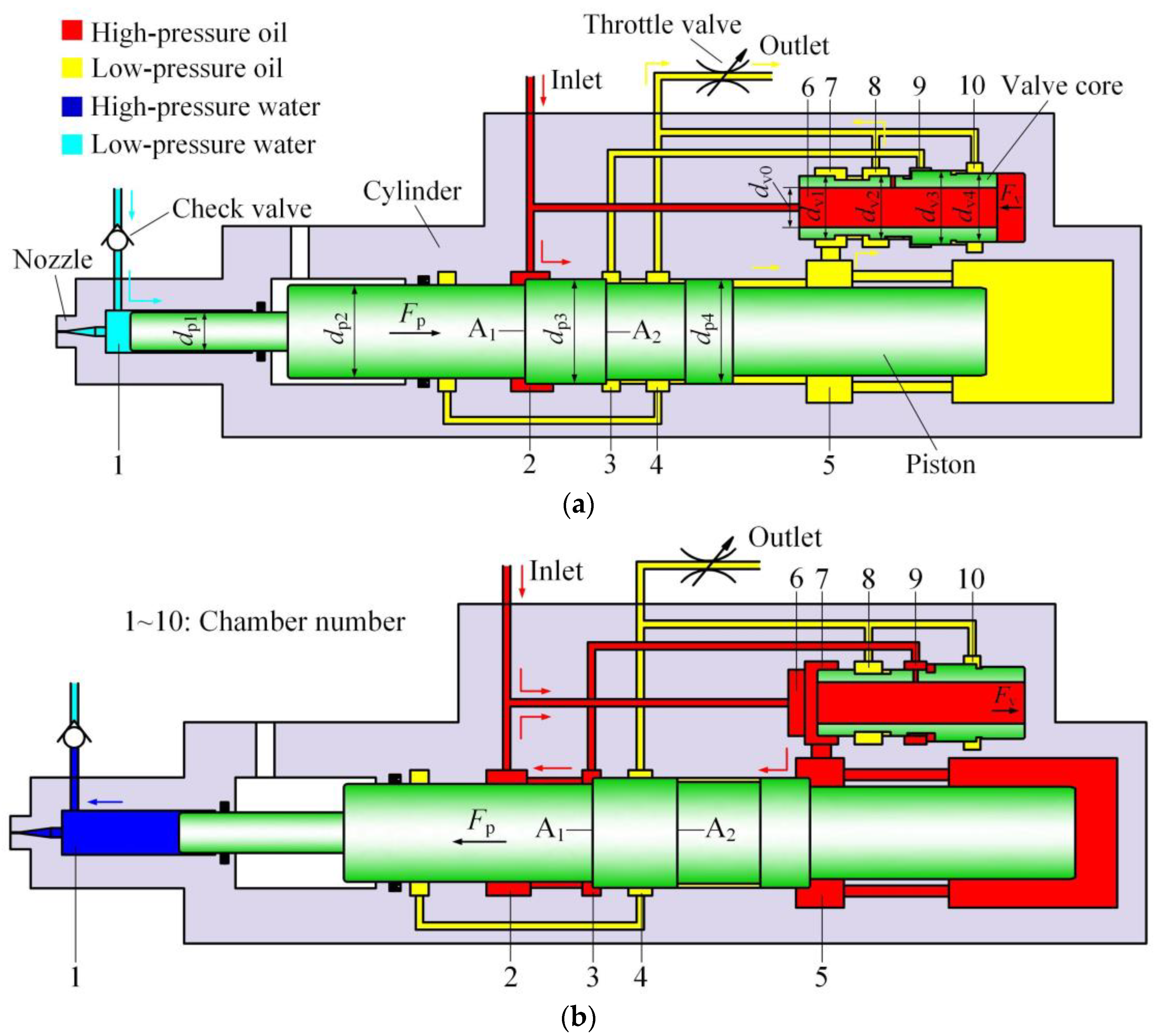
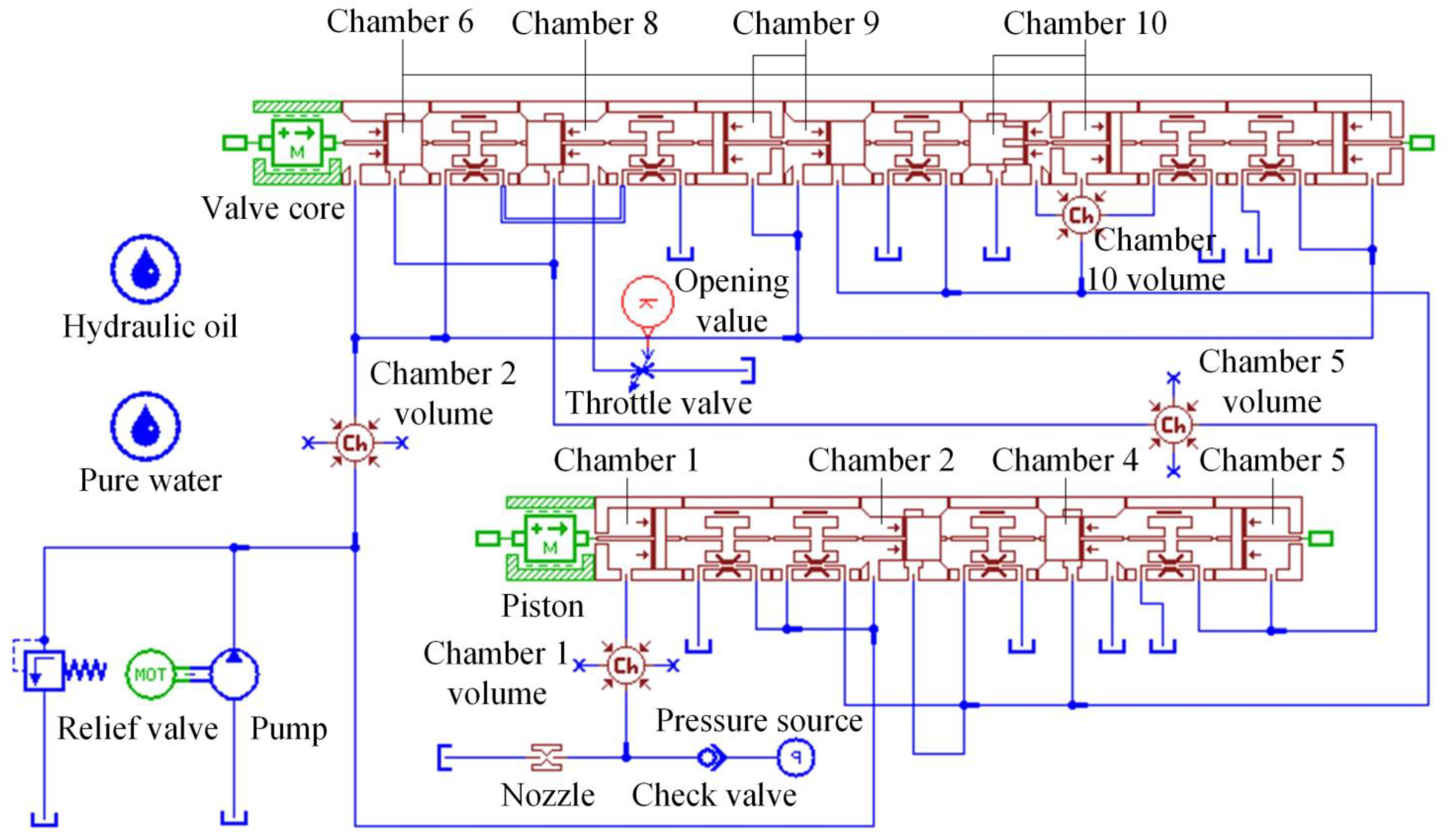

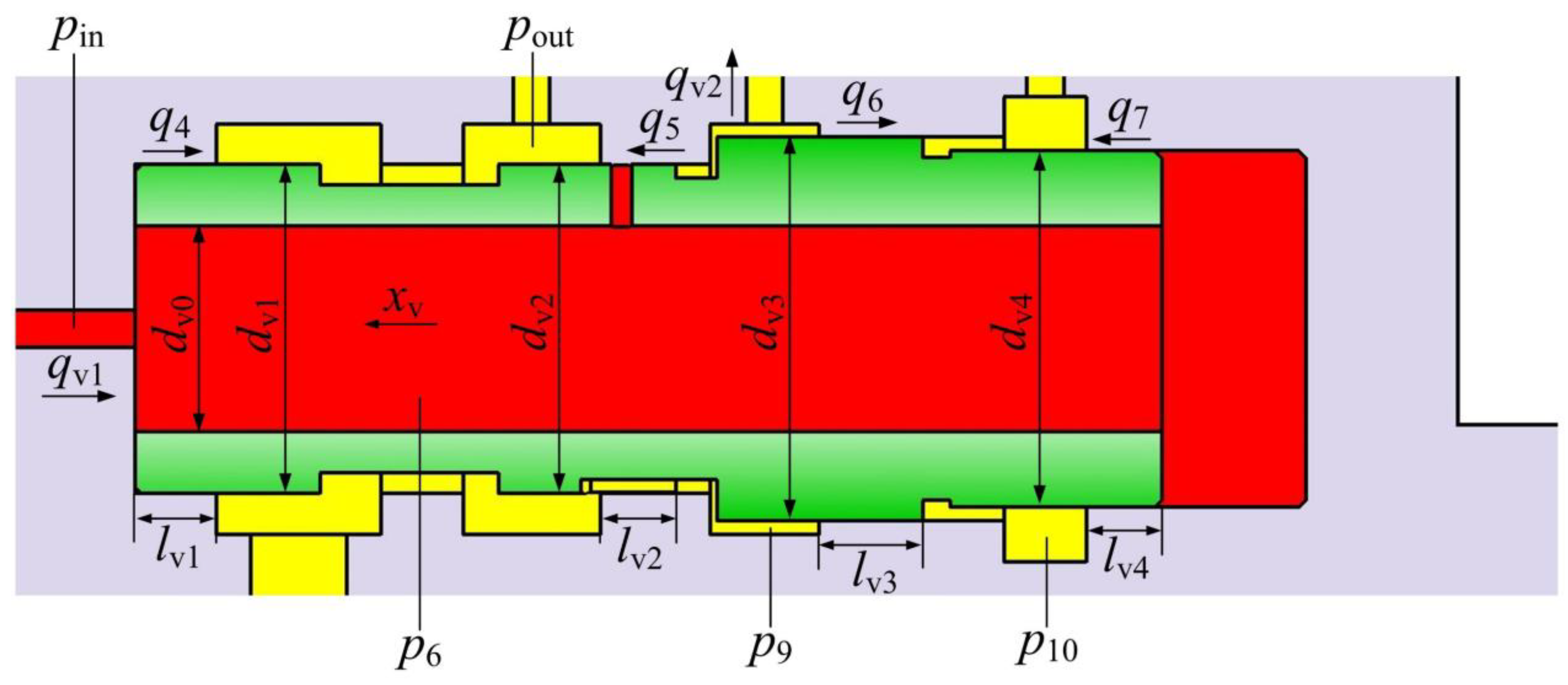
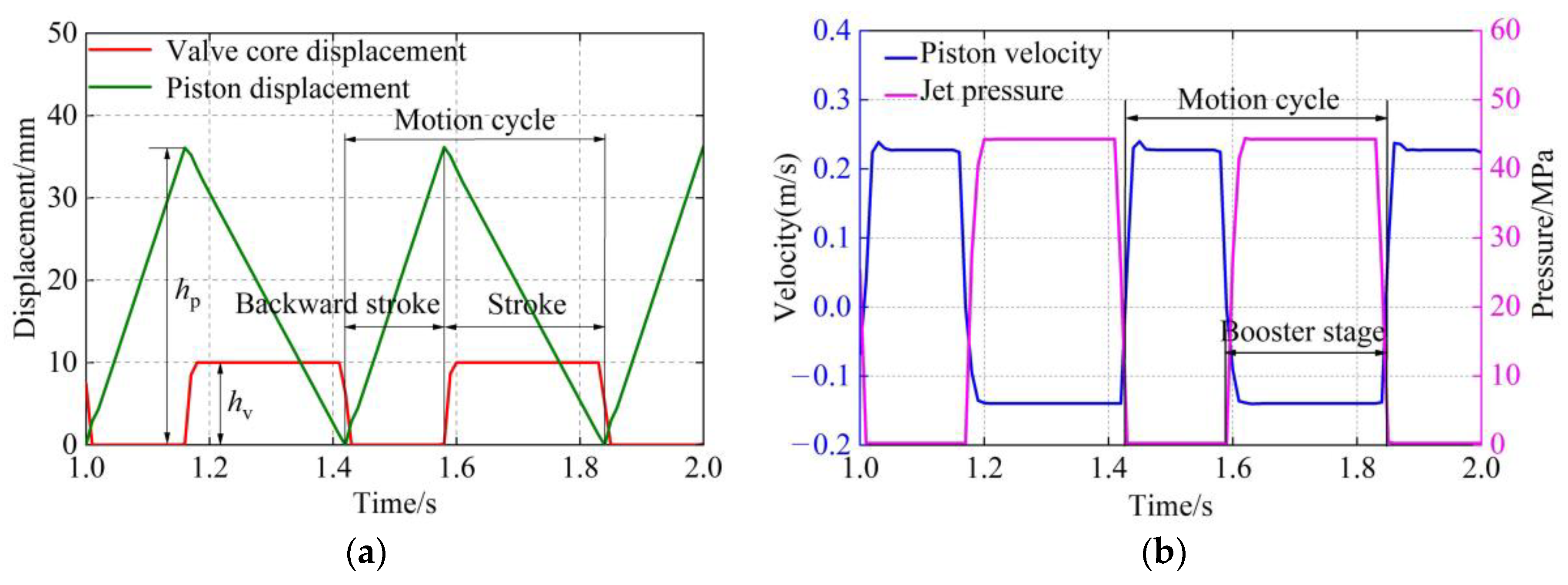

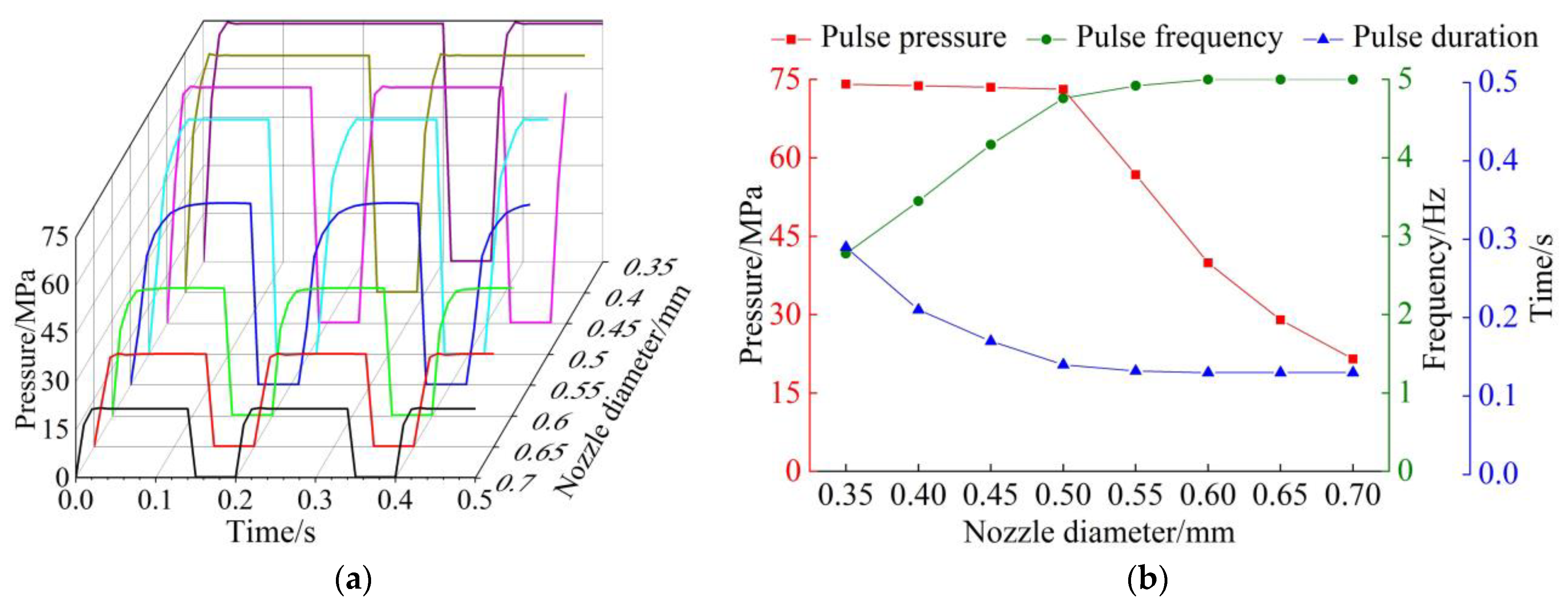

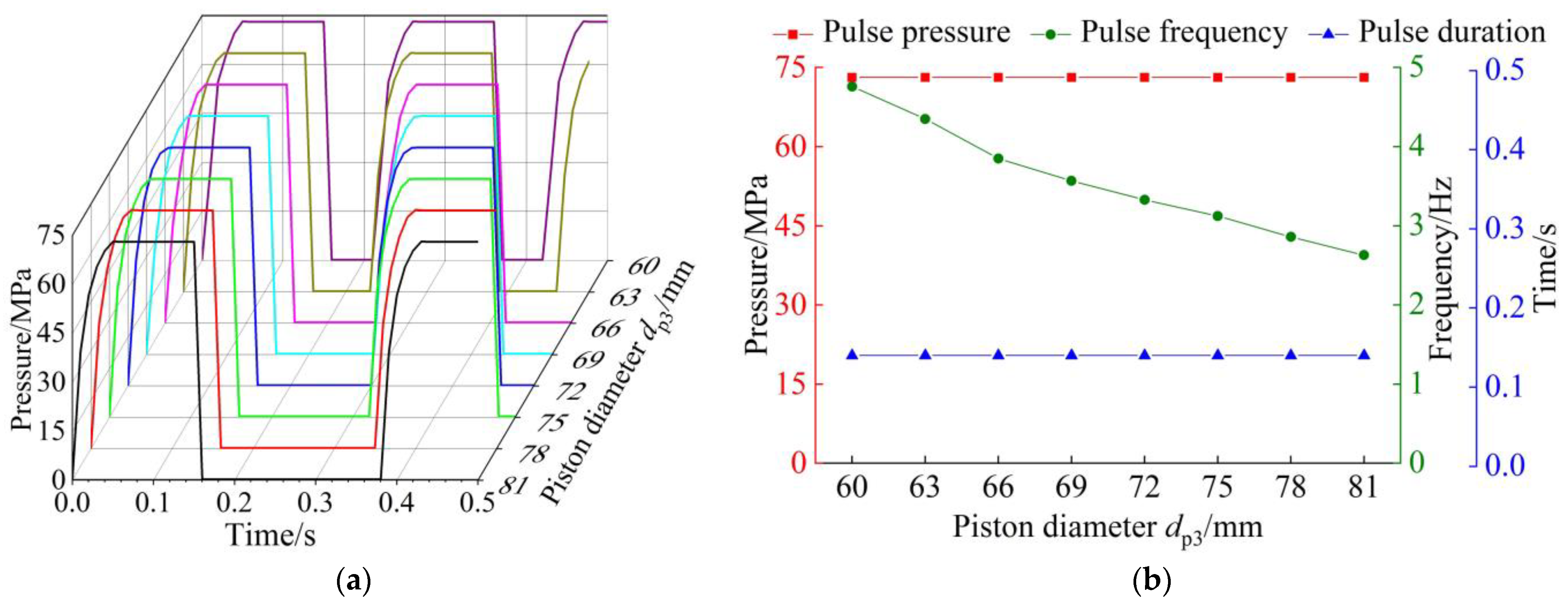
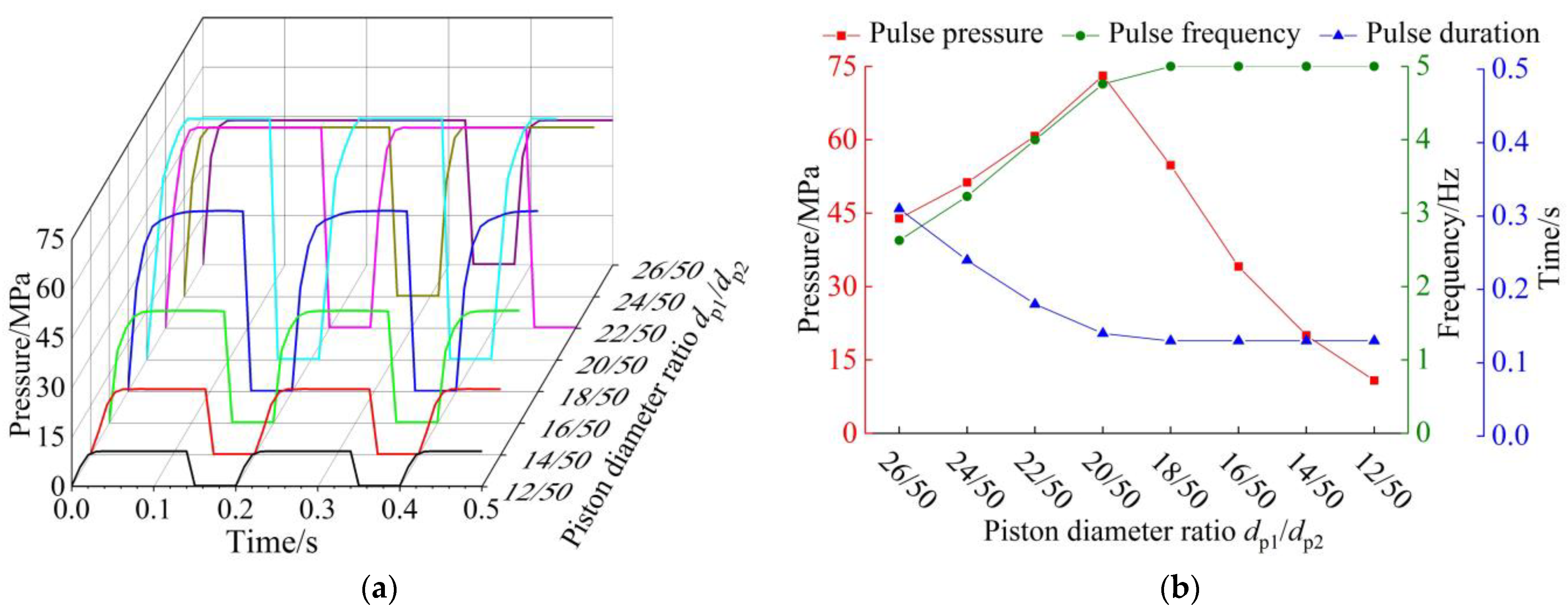
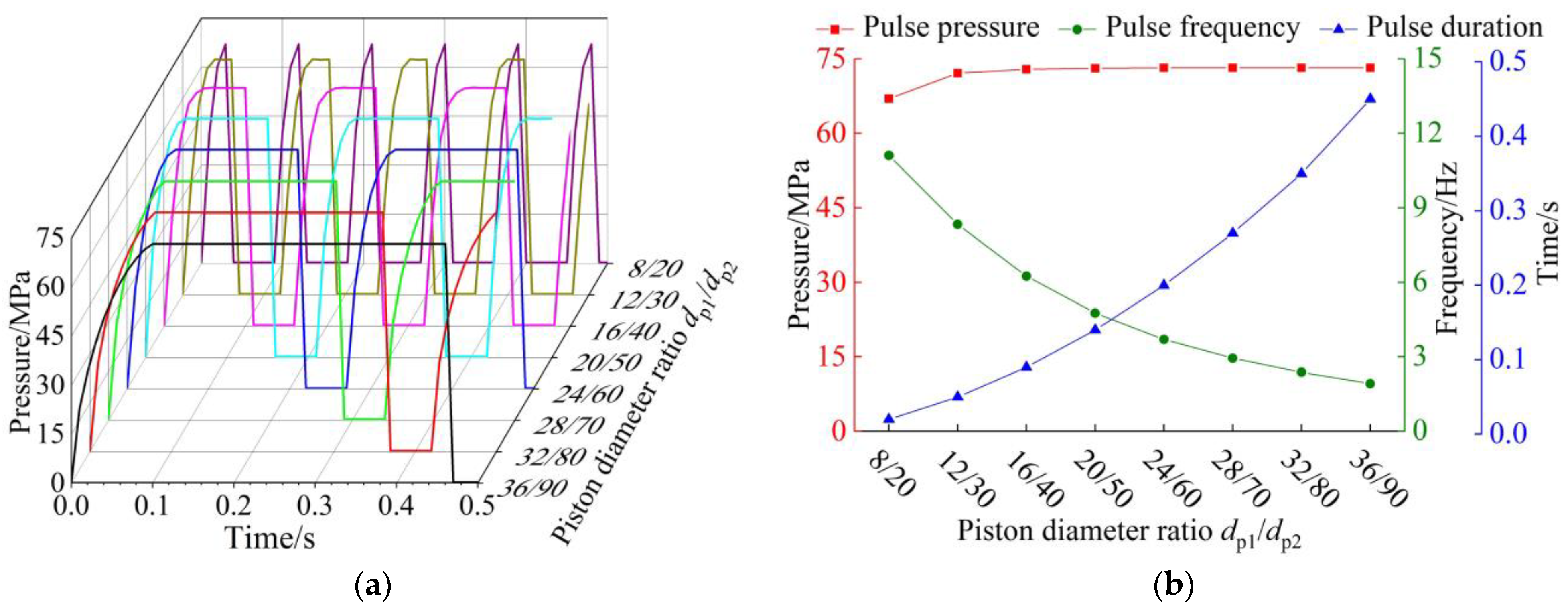
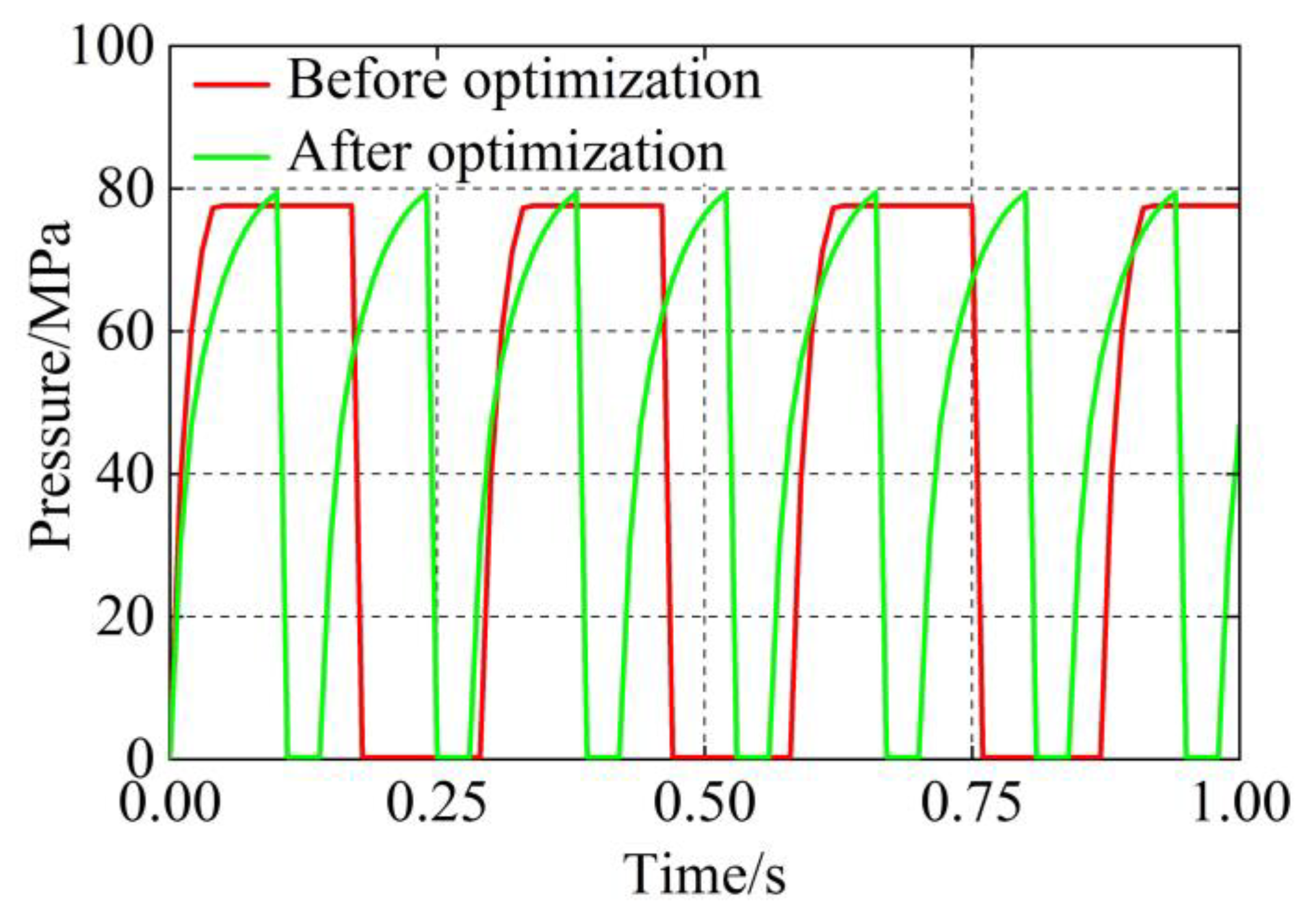
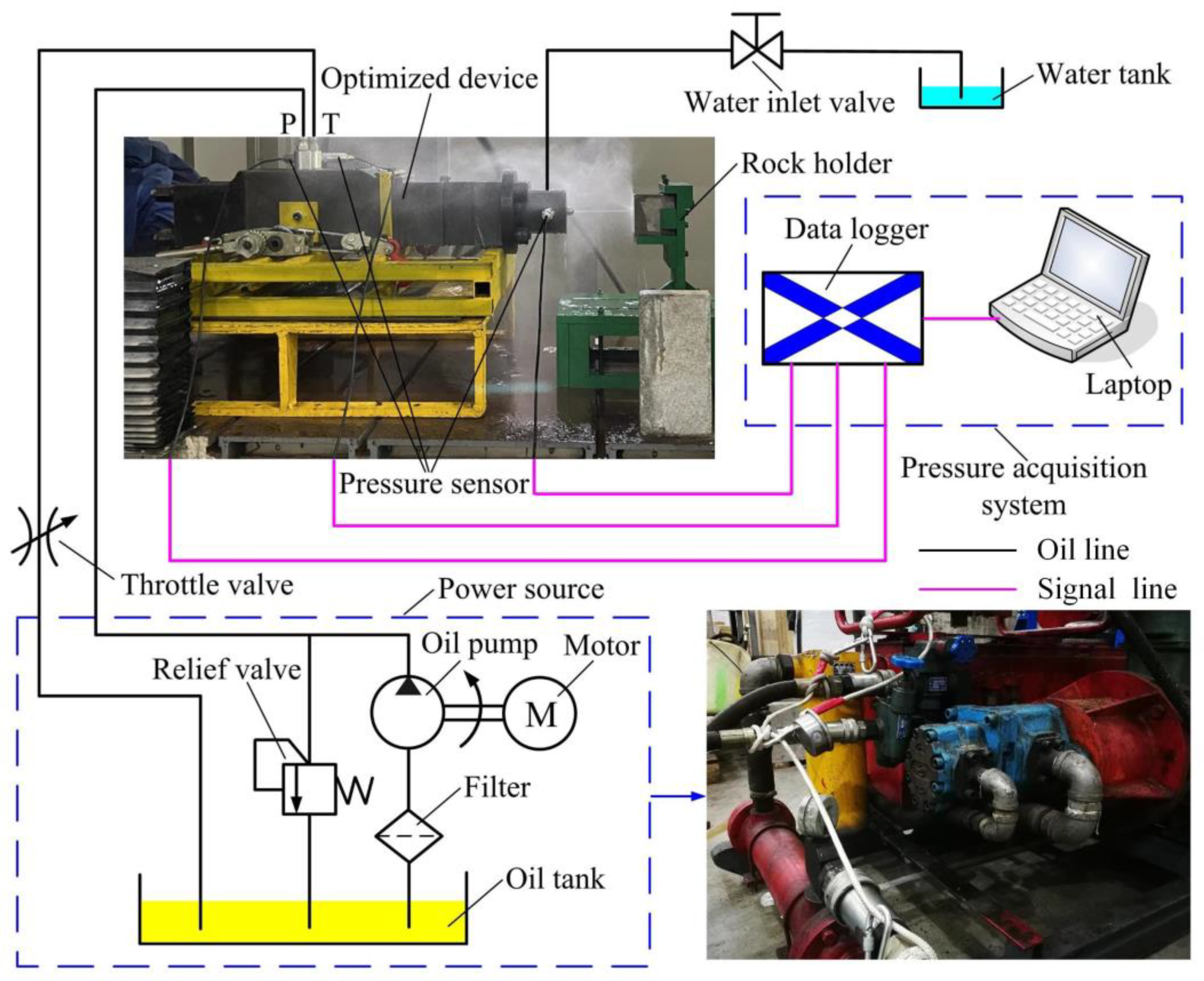
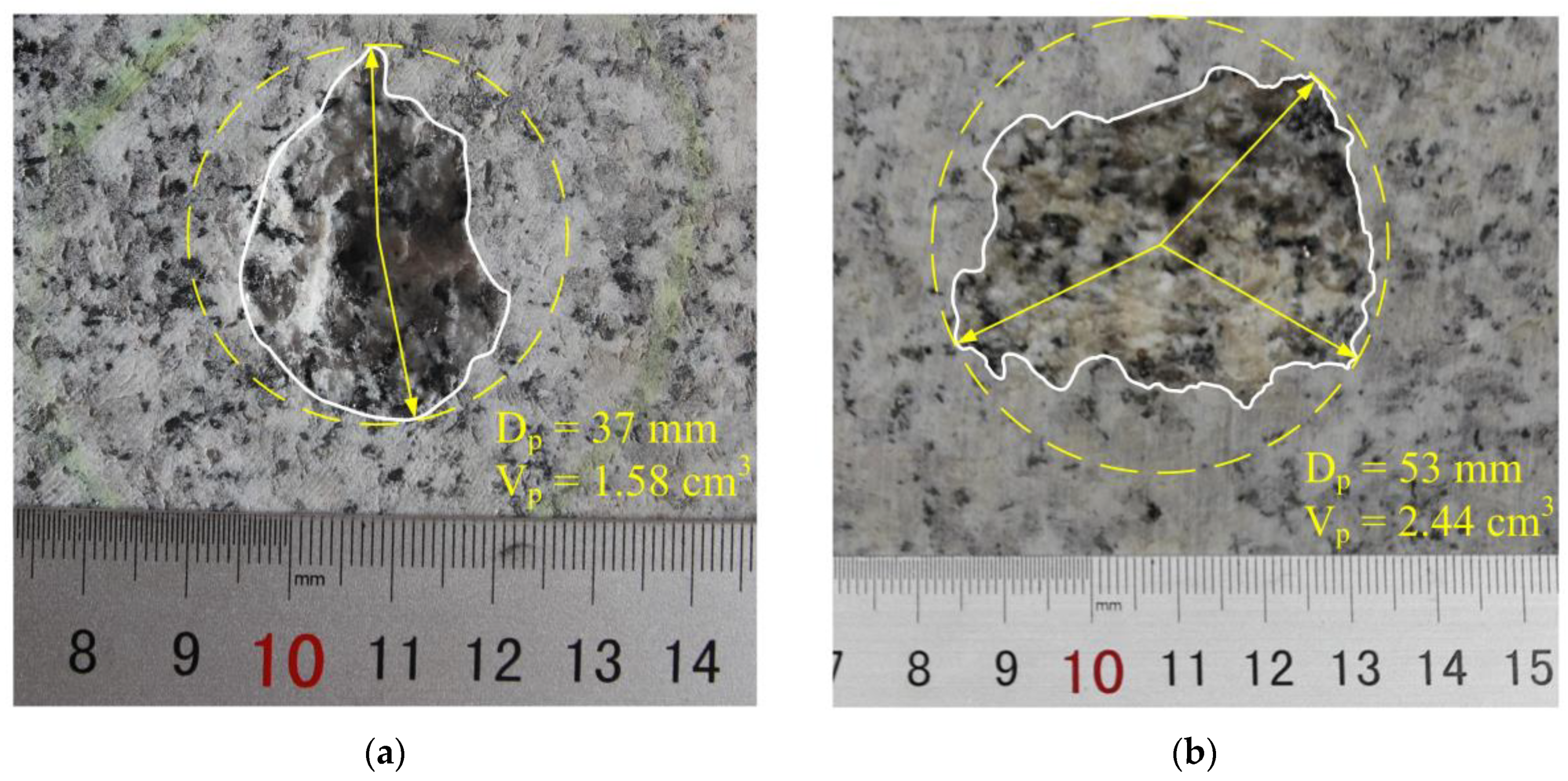
| Parameters | Value | Parameters | Value |
|---|---|---|---|
| Piston outer diameter dp1 (mm) | 22 | Valve core outer diameter dv2 (mm) | 24 |
| Piston outer diameter dp2 (mm) | 53 | Valve core outer diameter dv3 (mm) | 28 |
| Piston outer diameter dp3 (mm) | 60 | Valve core outer diameter dv4 (mm) | 26 |
| Piston outer diameter dp4 (mm) | 60 | Valve core maximum displacement hv (mm) | 10 |
| Piston maximum displacement hp (mm) | 35 | Rated flow rate of the pump qr (L/min) | 30 |
| Nozzle diameter dn (mm) | 0.45 | Water inlet pressure p0 (MPa) | 0.3 |
| Nozzle discharge coefficient Cd | 0.95 | Hydraulic oil viscosity μ (mm2/s) | 48 |
| Valve core inner diameter dv0 (mm) | 15 | Hydraulic oil bulk modulus Ke (MPa) | 1200 |
| Valve core outer diameter dv1 (mm) | 24 | Water density ρw0 (kg/m3) | 1000 |
| Structural Parameters | Initial Value | Value Range | Gradient |
|---|---|---|---|
| Nozzle diameter dn (mm) | 0.5 | 0.35–0.7 | 0.05 |
| Piston maximum displacement h (mm) | 35 | 20–55 | 5 |
| Piston diameter dp3 (mm) | 60 | 57–78 | 3 |
| Variable diameter ratio dp1/dp2 | 20/50 | 12–26/50–50 | 2/0 |
| Fixed diameter ratio dp1/dp2 | 20/50 | 8–36/20–90 | 4/10 |
Disclaimer/Publisher’s Note: The statements, opinions and data contained in all publications are solely those of the individual author(s) and contributor(s) and not of MDPI and/or the editor(s). MDPI and/or the editor(s) disclaim responsibility for any injury to people or property resulting from any ideas, methods, instructions or products referred to in the content. |
© 2024 by the authors. Licensee MDPI, Basel, Switzerland. This article is an open access article distributed under the terms and conditions of the Creative Commons Attribution (CC BY) license (https://creativecommons.org/licenses/by/4.0/).
Share and Cite
Ling, Y.; Wang, X.; Tang, J. Dynamic Simulation Model and Performance Optimization of a Pressurized Pulsed Water Jet Device. Appl. Sci. 2024, 14, 6788. https://doi.org/10.3390/app14156788
Ling Y, Wang X, Tang J. Dynamic Simulation Model and Performance Optimization of a Pressurized Pulsed Water Jet Device. Applied Sciences. 2024; 14(15):6788. https://doi.org/10.3390/app14156788
Chicago/Turabian StyleLing, Yuanfei, Xiaoqiang Wang, and Jiren Tang. 2024. "Dynamic Simulation Model and Performance Optimization of a Pressurized Pulsed Water Jet Device" Applied Sciences 14, no. 15: 6788. https://doi.org/10.3390/app14156788




